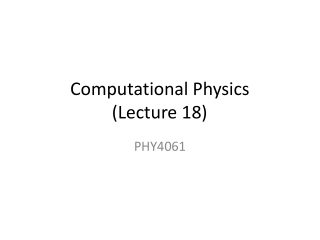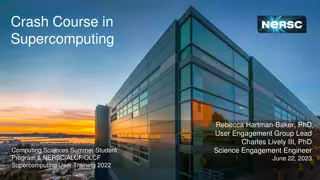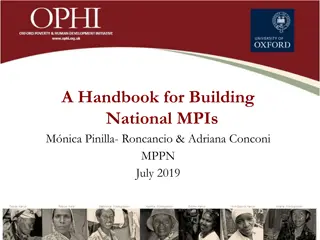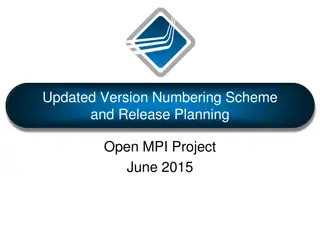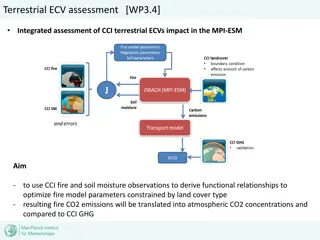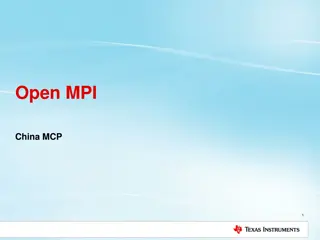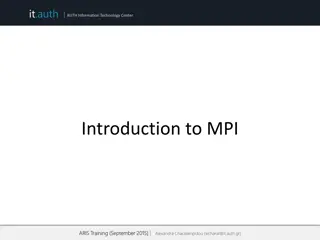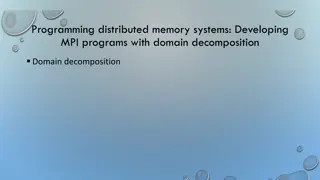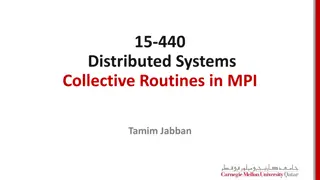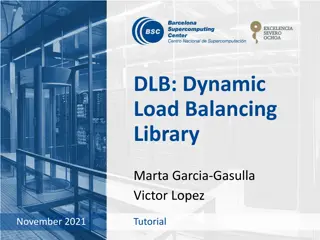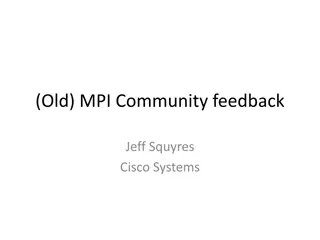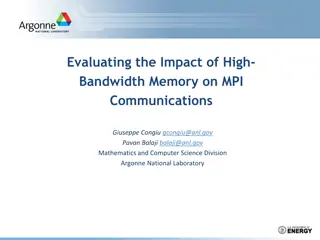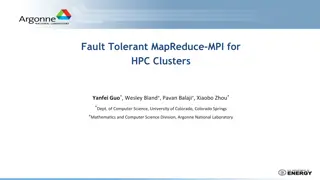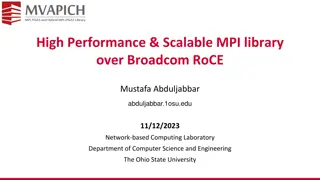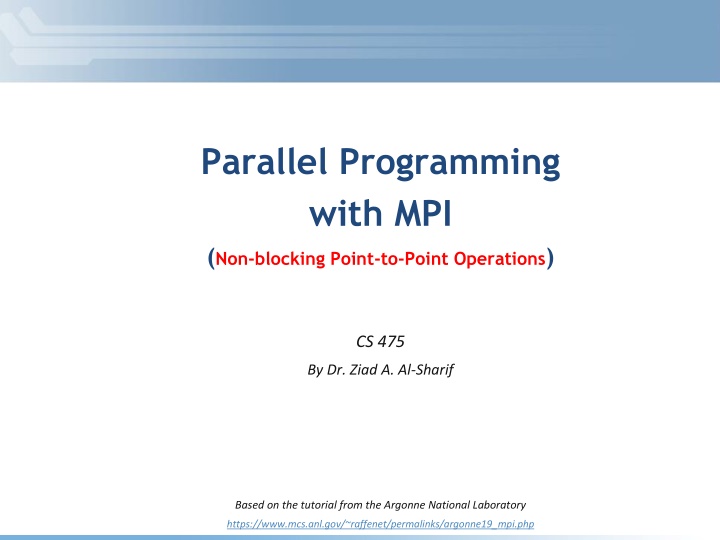
MPI Non-Blocking Point-to-Point Operations Tutorial
Explore the differences between blocking and non-blocking communication in MPI programming with a focus on MPI_SEND/MPI_RECV versus MPI_ISEND/MPI_IRECV functions. Learn how non-blocking operations improve performance by overlapping computation and communication.
Uploaded on | 1 Views
Download Presentation

Please find below an Image/Link to download the presentation.
The content on the website is provided AS IS for your information and personal use only. It may not be sold, licensed, or shared on other websites without obtaining consent from the author. If you encounter any issues during the download, it is possible that the publisher has removed the file from their server.
You are allowed to download the files provided on this website for personal or commercial use, subject to the condition that they are used lawfully. All files are the property of their respective owners.
The content on the website is provided AS IS for your information and personal use only. It may not be sold, licensed, or shared on other websites without obtaining consent from the author.
E N D
Presentation Transcript
Parallel Programming with MPI (Non-blocking Point-to-Point Operations) CS 475 By Dr. Ziad A. Al-Sharif Based on the tutorial from the Argonne National Laboratory https://www.mcs.anl.gov/~raffenet/permalinks/argonne19_mpi.php
Blocking vs. Nonblocking Communication MPI_SEND/MPI_RECVare blocking communication calls Return of the routine implies completion When these calls return the memory locations used in the message transfer can be safely accessed for reuse For send completion implies variable sent can be reused/modified Modifications will not affect data intended for the receiver For receive variable received can be read MPI_ISEND/MPI_IRECV are nonblocking variants Routine returns immediately completion has to be separately tested for These are primarily used to overlap computation and communication to improve performance 2
Blocking Communication In blocking communication MPI_SENDdoes not return until buffer is empty (available for reuse) MPI_RECVdoes not return until buffer is full (available for use) A process sending data will be blocked until data in the send buffer is emptied A process receiving data will be blocked until the receive buffer is filled Exact completion semantics of communication generally depends on the message size and the system buffer size Blocking communication is simple to use but can be prone to deadlocks if (rank == 0) { MPI_SEND(..to rank 1..) MPI_RECV(..from rank 1..) Usually deadlocks }else if (rank == 1) { MPI_SEND(..to rank 0..) reverse send/recv MPI_RECV(..from rank 0..) } 3
Blocking Send-Receive Diagram T0:MPI_Recv Once receive is called @ T0, buffer unavailable to user T1:MPI_Send time T2 Sender returns @T2, buffer can be reused T3: Transfer Complete T4 Receive returns @T4, buffer filled internal completion is soon followed by return of MPI_Recv Receiver Sender 4 4
Nonblocking Communication Nonblocking operations return (immediately) request handles that can be waited on and queried MPI_ISEND(buf, count, datatype, dest, tag, comm, request) MPI_IRECV(buf, count, datatype, src, tag, comm, request) MPI_WAIT(request, status) Nonblocking operations allow overlapping computation and communication One can also test without waiting using MPI_Test MPI_Test(request, flag, status) Anywhere you use MPI_Send orMPI_Recv, you can use the pair ofMPI_Isend/MPI_Wait orMPI_Irecv/MPI_Wait 5
Nonblocking Send-Receive Diagram High Performance Implementations Offer Low Overhead for Nonblocking Calls T0:MPI_Irecv T2:MPI_Isend T1:Returns Sender returns @T3, buffer unavailable T3 time Sender completes @T5, buffer available after MPI_Wait T5 T6 T6:MPI_Wait T7: Transfer Finishes T9: Wait returns MPI_Wait, returns @ T8 here, receive buffer filled T8 internal completion is soon followed by return of MPI_Recv 6 Receiver Sender 6
Multiple Completions It is sometimes desirable to wait on multiple requests: MPI_Waitall(count, array_of_requests, array_of_statuses) MPI_Waitany(count, array_of_requests, &index, &status) MPI_Waitsome(incount, array_of_requests, outcount, array_of_indices, array_of_statuses) Thereare corresponding versions of TEST for each of these 7
Message Completion and Buffering For a communication to succeed: Sender must specify a valid destination rank Receiver must specify a valid source rank (including MPI_ANY_SOURCE) The communicator must be the same Tags must match Receiver s buffer must be large enough A send has completed when the user supplied buffer can be reused *buf = 3; MPI_Send(buf, 1, MPI_INT ) *buf = 4; /* OK, receiver will always receive 3 */ *buf = 3; MPI_Isend(buf, 1, MPI_INT ) *buf = 4; /* Receiver may get 3, 4, or anything else */ MPI_Wait( ); Just because the send completes does not mean that the receive has completed Message may be buffered by the system Message may still be in transit 8
A Nonblocking communication example int main(int argc, char ** argv) { [...snip...] if (rank == 0) { for (i=0; i< 100; i++) { /* Compute each data element and send it out */ data[i] = compute(i); MPI_Isend(&data[i], 1, MPI_INT, 1, 0, MPI_COMM_WORLD, &request[i]); } MPI_Waitall(100, request, MPI_STATUSES_IGNORE) } else if (rank == 1){ for (i = 0; i < 100; i++) MPI_Recv(&data[i], 1, MPI_INT, 0, 0, MPI_COMM_WORLD, MPI_STATUS_IGNORE); } [...snip...] } 9
Section Summary Nonblocking communication is an enhancement over blocking communication Allows for computation and communication to be potentially overlapped MPI implementation might, but is not guaranteed to overlap Depends on what capabilities the network provides Depends on how the MPI library is implemented (e.g., some libraries might tradeoff between better overlap and better basic performance) Critical for event-driven programming Multiple outstanding operations, and the application performs a corresponding task depending on what completes next 10
Running Example: Stencil Reference: Coursera: Stencil Introduction https://www.coursera.org/lecture/parallelism-ia/stencil-introduction-n0utd
Running Example: Regular Mesh Algorithms Many scientific applications involve the solution of partial differential equations (PDEs) Many algorithms for approximating the solution of PDEs rely on forming a set of difference equations Finite difference, finite elements, finite volume The exact form of the differential equations depends on the particular method From the point of view of parallel programming for these algorithms, the operations are the same Five-point stencil is a popular approximation solution 12
The Global Data Structure Each circle is a mesh point Difference equation evaluated at each point involves the four neighbors The red plus is called the method s stencil Good numerical algorithms form a matrix equation Au=f; solving this requires computing Bv, where B is a matrix derived from A. These evaluations involve computations with the neighbors on the mesh. 13
The Global Data Structure Each circle is a mesh point Difference equation evaluated at each point involves the four neighbors The red plus is called the method s stencil Good numerical algorithms form a matrix equation Au=f; solving this requires computing Bv, where B is a matrix derived from A. These evaluations involve computations with the neighbors on the mesh. Decompose mesh into equal sized (work) pieces 14
The Local Data Structure Each process has its local patch of the global array bx and by are the sizes of the local array Always allocate a halo around the patch Array allocated of size (bx+2)x(by+2) by bx 16
Necessary Data Transfers Provide access to remote data through a halo exchange (5 point stencil) 18
Example: Stencil with Nonblocking Send/recv nonblocking_p2p/stencil.c Simple stencil code using nonblocking point-to-point operations 19

